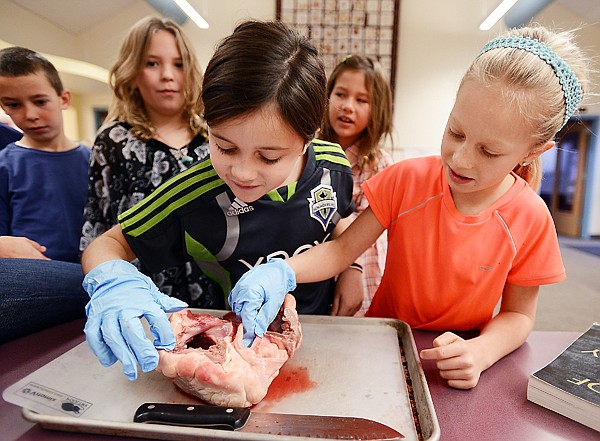Montessori students learn heart smarts
HILARY MATHESON | Hagadone News Network | UPDATED 13 years AGO
Gasps of awe and revulsion filled a room at Kalispell Montessori Elementary School recently when a large cow heart was displayed before sixth-graders.
“That is as big as my head,” one student said.
“It’s kind of scary,” said another as students clustered around the heart held up by Jennifer Hawes, a naturopathic physician and owner of The Balance Clinic in Kalispell.
“How big is your heart?” Hawes asked. Students raised clenched fists in reply.
“When you’re born, your heart is the size of a baby’s fist. Can you believe that?” Hawes said. “It grows and you get older.”
An average cow heart weighs about 5 pounds compared to the 9- to 11-ounce adult human heart.
Hawes brought seven cow hearts donated by Sykes’ Market for the students to dissect.
The sixth-graders were in for an afternoon of exploring the vital organ responsible for pumping oxygenated and nutrient-rich blood throughout the body.
“Without lungs, your heart really doesn’t have a job,” Hawes said.
Upper-elementary teacher David Cummings said the school often invites parents to share their expertise with students. Hawes’ children — Ellie, 8, and Jalen, 10 — attend the school.
“My biggest goal here is to inspire kids to do science,” Hawes said.
Cummings said the sixth-graders recently have focused studies on the human body in addition to learning about other mammals and invertebrates. Cummings has done a few dissection demonstrations during his tenure at the school, but this is the first time students have held the scalpels themselves.
Whether the students were fearful or excited about dissecting, curiosity got the best of everyone who split into small groups and took turns using scalpels to slice open the thick, muscular organ.
Nico Young, 12, Stephen Bridges, 12, and Jascah Vann, 11, tentatively poked at the heart set before them with gloved fingers.
“It’s weird,” Bridges said.
“Whoa, it’s hard,” Young said, touching fatty tissue.
Young picked up a scalpel and made vertical slices down the length of the heart. Hawes stopped at the table to point out things such as the aorta or superior vena cava.
“Poke your fingers down those tubes on the top. They go right down to the big muscle,” Hawes said, demonstrating.
Young and Vann slid their fingers along the smooth lining of the aorta and scrunched their faces when Hawes closed flaps of a heart valve, which shuts to prevent blood from flowing backward.
Young continued to slice different areas of the heart. “Look inside of it,” he said. The group pulled the heart flat, exposing the inside.
“The left side of the heart is bigger in volume because it shoots blood all the way to your head to toes,” Hawes said. “The right side of the heart’s job is to pump to the lungs right next to the heart. That’s why it’s smaller.”
Hawes said the response from students is what science is all about.
“They’re touching, seeing and even smelling,” Hawes said.
And tasting.
Not far from the dissections was a small kitchen where one of the hearts was cooked over a stove. Later on, Cummings brought out two plates of chopped cow heart for the children to taste. Goading each other, most took a small piece. Some pieces only reached the tip of a student’s tongue before hitting the garbage can; others claimed it tasted like a chewy steak.
“I love teaching and getting people excited about science,” Hawes said.
Reporter Hilary Matheson may be reached at 758-4431 or by email at [email protected].
ARTICLES BY HILARY MATHESON

Christmas tradition: Business continues helping customers capture the holiday spirit
Snowline Acres owners Tom and Kristin Davis are approaching a decade of helping people celebrate the most wonderful time of the year.
Whitefish High School wins East Helena speech and debate tournament
Scoring 225 points, the Whitefish High School speech and debate team took first place at a weekend tournament.

Glacier High speech and debate team secures second in Bozeman
The Glacier High School speech and debate team secured second place, and Flathead High School, third in Bozeman.



